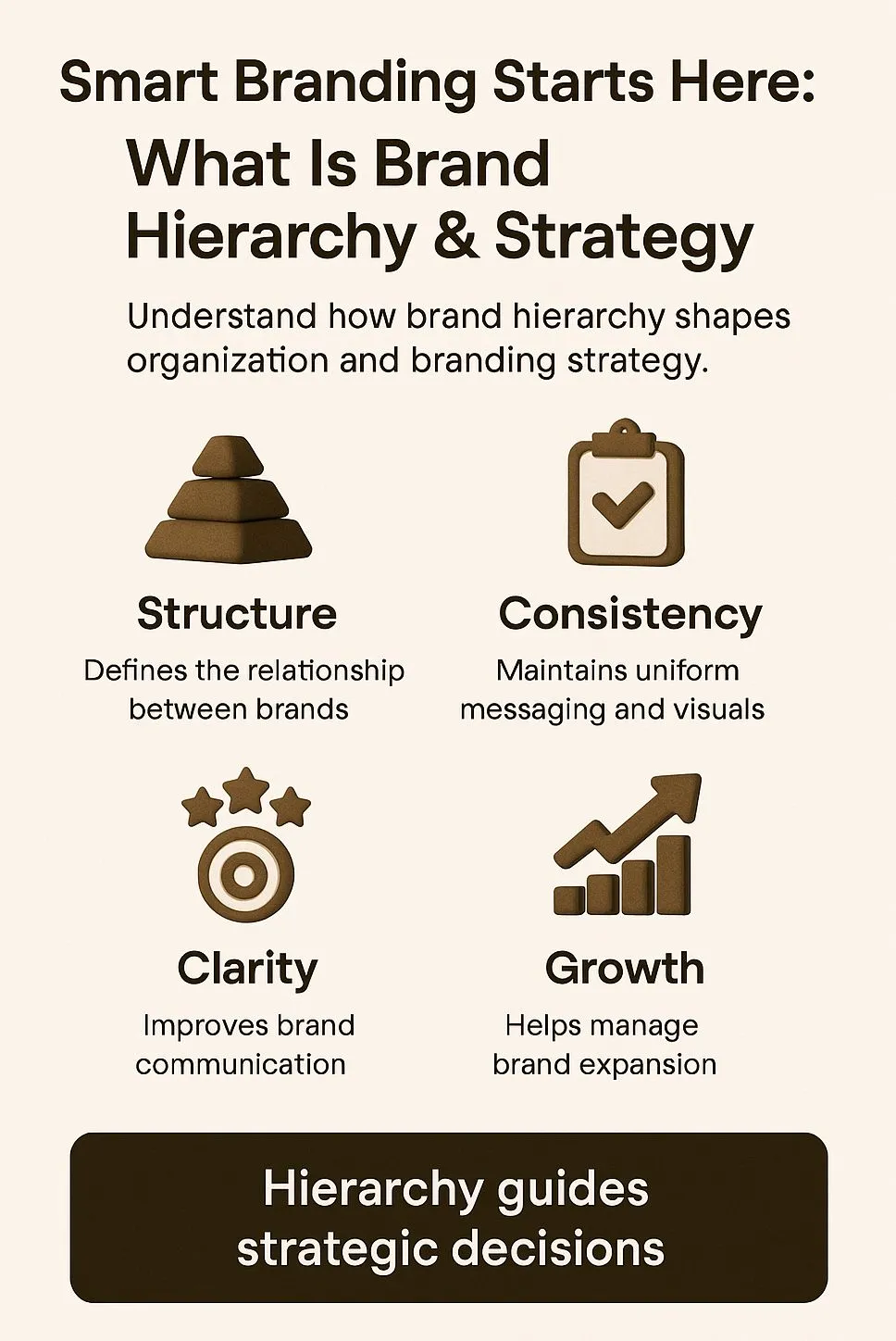Brand success isn’t just about creativity—it’s about clarity. Over the years, we’ve worked with ambitious companies aiming to scale, differentiate, and grow. Yet one of the most overlooked pillars of brand strategy is also one of the most powerful: brand hierarchy.
Understanding and applying what is brand hierarchy doesn’t just help organize your business—it enhances perception, boosts marketing efficiency, and lays the foundation for long-term equity. This article breaks down how hierarchy fits into smart branding and how to use it as a strategic advantage.
Top Takeaways
- Brand hierarchy adds structure and clarity.
- It builds trust, consistency, and brand equity.
- Clear organization aligns teams and messaging.
- Early structure supports smoother brand growth.
Small businesses benefit from simple brand systems.
What Is Brand Hierarchy—and Why It Matters in Strategy
Brand hierarchy refers to the system a company uses to structure and relate its master brand, sub-brands, endorsed brands, and individual offerings. This structure isn't cosmetic—it's strategic. It dictates how your audiences navigate your brand and how internal teams align around messaging and growth.
When brand relationships aren’t clearly defined, customer confusion increases and brand equity erodes. But when hierarchy is implemented intentionally, it drives consistency, loyalty, and trust.
“We’ve seen it time and again: brands that invest in structure scale more clearly, communicate more effectively, and earn deeper customer confidence.” This insight is especially evident when working with female owned SEO marketing companies, where thoughtful brand hierarchy empowers focused storytelling and strong market positioning.

A Case in Point: From Disjointed Brands to Unified Strategy
We helped a national home services provider that had grown rapidly through acquisitions. Each region operated under different names and visuals—leading to mixed messaging, higher costs, and low brand recognition.
The Challenge:
Inconsistent brand presentation across locations
Disconnected customer experiences
High marketing expenses due to duplicated efforts
Our Solution:
Elevated the parent brand to serve as the visible, unified identity
Retained local brands with endorsed branding ("Powered by...") to preserve equity
Simplified service categories and naming conventions to align language and messaging
The Results:
43% growth in brand recognition within six months
21% reduction in marketing costs
Measurable increase in customer trust across markets
This transformation wasn’t just about appearances—it was about strategy. With hierarchy in place, the brand became more scalable, recognizable, and trusted, aligning seamlessly with broader goals like sustainability in marketing, where clarity and purpose drive lasting value.
Strategy Backed by Data
Data reinforces the strategic value of brand hierarchy:
81% of U.S. consumers say trust is a must-have before buying
Source: Edelman Trust BarometerConsistent branding can increase revenue by up to 20%
Source: Lucidpress Branding Benchmark ReportMarketing strategy roles are projected to grow 8% by 2033
Source: U.S. Bureau of Labor Statistics
From trust to efficiency, structure creates value—and smart brands know how to harness it through well-executed digital marketing strategies that align brand architecture with audience expectations.
Key Strategy Insights
Brand hierarchy simplifies complex portfolios and aligns teams
It reduces waste by unifying design, language, and messaging
Early structure supports easier expansion, acquisitions, and product launches
It directly contributes to brand equity, customer retention, and perception
How to Implement Brand Hierarchy Strategically
Ready to bring more clarity and cohesion to your brand? Start here:
Audit your current brand structure
List all sub-brands, services, and logos to identify inconsistencies.Clarify your brand levels
Group each asset into master brand, sub-brand, endorsed brand, or stand-alone.Unify visual and verbal identity
Ensure all elements align across design, voice, and positioning.Document your architecture
Create a brand structure map and style guide to keep everyone aligned.Engage leadership and marketing teams
Strategy only works when it's understood and implemented across roles.
Frequently Asked Questions
What is brand hierarchy in branding strategy?
It’s the way a company organizes brands and products under a structured system to improve clarity, recognition, and efficiency.
Why is brand hierarchy essential to growth?
Without it, your messaging becomes fragmented. With it, your brand scales smoothly while retaining consistency and trust.
How many brand levels are common?
Most hierarchies include:
Master (corporate) brand
Endorsed brands
Sub-brands
Standalone products
Can smaller businesses use brand hierarchy?
Absolutely. Even a simple structure helps define your offering, sharpen messaging, and build equity over time.
When should I revisit brand hierarchy?
During expansion, mergers, rebranding, or anytime confusion or inconsistency arises.
When building a strong and scalable brand, understanding the principles behind Smart Branding Starts Here: What Is Brand Hierarchy & Strategy is essential. A clear brand hierarchy not only shapes how your audience perceives your offerings but also ensures consistent messaging across platforms and product lines. This concept is especially relevant in industries like HVAC, where trusted names and clear product tiers guide consumer choices. For example, the 24x28x2 Air Filters page reflects how a well-defined product structure supports both brand clarity and performance expectations. Reputable service networks such as HVAC Repair Service reinforce how service quality can be an extension of brand identity. On e-commerce platforms, consistent product representation also plays a role—whether through the 17.5x23.5x1 Pleated Furnace Filters on Amazon, the 12x24x1 MERV 8 Air Filters at Walmart, or listings like the HVAC Furnace Filter on eBay. Each of these reflects strategic decisions in naming, tiering, and distribution that support a cohesive and recognizable brand system—an essential goal of brand hierarchy and strategy.








